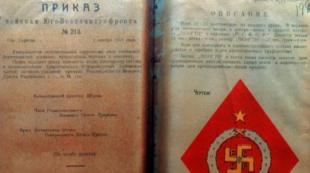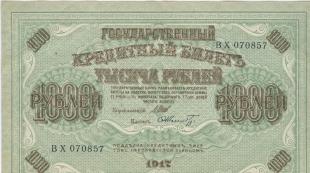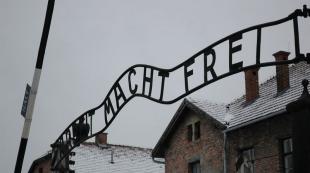Swastika in the Red Army. The swastika during the period of the "provisional" government and the times of the civil war. reasons why you need a quote
SWASTIKA ON PAPER MONEY OF THE SOVIET AUTHORITY
The presence of a swastika on the money of the early period of the Land of the Soviets is a historical fact. This is known to many people who are interested in the historical aspects of money circulation in Russia, bonist collectors and historians. I want to say right away that my short note is not propaganda of fascism, moreover, I have a sharply negative attitude towards the ideology of fascism.
The swastika is a cross with curved ends. The ends of the cross are directed clockwise or counterclockwise. The swastika is one of the most ancient symbols. In ancient India, the swastika is a solar sign, a greeting, a wish of good luck. And after fascist Germany made this symbol the emblem of fascism, it began to carry a negative character. And now for me the swastika is a negative sign, as well as for the majority of the population of the whole world. And of course, for modern people to recognize or see the sign of the swastika on the paper money of the RSFSR (Russian Socialist Federal Republic) causes, to put it mildly, bewilderment, or even shock.
Once, a collector, now an archivist, and in his youth he was a history teacher, told me a funny story. In his history lessons, he told the children that in a certain period of Soviet power, there was money with a swastika. Of course, this sensational information began to be discussed by children. The management also found out about this, they called him to the “carpet” to the director and began to harshly dismantle him for anti-Soviet agitation. The teacher had to bring this paper money to the school and show it to his little-informed colleagues. Anyway, the teachers punished and made it look like it was unacceptable to present such information to the fragile minds of secondary school students.
So, in February 1917, a bourgeois revolution took place in Russia, the monarchy was overthrown and power passed to the Provisional Government. And the new government naturally wanted to introduce its new money. On April 26 and August 22, 1917, the Provisional Government issued a decree on the issuance of credit notes in denominations of 250 and 1000 rubles. On the new banknotes, a new state emblem of Russia was placed, recommended for use by a legal conference under the Provisional Government. The drawing of the new coat of arms was developed by the artist I.Ya. Bilibin. The eagle became different, and most importantly, he did not have a crown - a symbol of autocracy (ill. 1). Now take a close look at the profile of the eagle, and you will see ... a swastika! And on the front side of the Russian banknote of 1000 rubles of 1917, there is also a swastika in the center (Fig. 2). An attentive reader will immediately ask a reasonable question: “what does the Soviet government and these tickets have to do with it?” Indeed, in Russia the Provisional Government was soon overthrown by the Bolsheviks, the October Revolution took place, which is also called the Great October Socialist Revolution. The fact is that after the Bolsheviks came to power and the creation of the RSFSR, money issued under tsarism, under the Provisional Government, and Soviet money (“sovznaki”) continued to be used in monetary circulation in the country for a long time. Moreover, the RSFSR continued to print the same royal money and the money of the Provisional Government with a swastika until 1921!
Let's return to the money of the Provisional Government with a swastika. A credit note of 1000 rubles of the 1917 model entered circulation on June 10, 1917. These credit notes were popularly called "dumki", because on the reverse side of the banknote there is an image of the State Duma of Russia of that period (ill. 3).
Il. 1. Rossi 250 rubles 1917 Reverse side.

Il.2. Russia 1000 rubles 1917. Size 213 x 132 mm. Front side.
And how to determine what year of issue a particular banknote of that very hot period? Indeed, from 1905 to 1922, there were revolutions in Russia, the First World War and the Civil War, devastation, famine, etc. There are several differences between such banknotes. One of the differences is that the banknotes on the front had the signature of the bank manager and cashier.
Russian paper money issues 1905 - 1909. were signed by the manager S.I. Timashev;
1910 - 1914 - the signature of the manager A.V. Konshin;
1914 - 1921 - signature of the manager I.P. Shipov.
I must say right away that not all paper money of the period of issue of 1905 - 1921. had signatures, for example, they were not on money-stamps and on the so-called "Kerenki".
 Il. 3. Russia 1000 rubles sample 1917. Reverse side.
Il. 3. Russia 1000 rubles sample 1917. Reverse side.
And how among the banknotes of 1917, to identify what period of issue they are, the Provisional Government or the RSFSR, because all of them bear the signature of I.P. Shipov? Indeed, all tickets are signed by the manager Shipov, regardless of the time of their release. However, they had different series. Credit notes of 1000 rubles of 1917 issue of the Provisional Government of the AA - AZ series. The Government of the RSFSR issued a series of AI - GO. The presented banknote of the BX series is the Soviet government (ill. 2). Each series with the same number was produced in a circulation of 200,000, i.e. from #000001 to #200000.
Ahh, the same banknotes were issued by the Provisional Government, the skeptic will say again, then there were difficult times, there was no time to figure out what the Provisional Government had issued and the Soviet government was not to blame (in terms of issuing paper money with a swastika).

Il. 4. RSFSR 5000 rubles 1918 rubles. Front side.

Il. 5. RSFSR 10,000 rubles 1918 Front side.
Yes, times were difficult. However, on October 21, 1919, a decree of the Council of People's Commissars of the RSFSR appeared on the issuance of banknotes of 5,000 and 10,000 rubles (ill. 4, 5), which entered circulation in December 1919. However, for their manufacture, design developments of banknotes carried out in 1917 under the Provisional Government, but with the new date "1918". The tickets featured the state emblem of Russia during the period of the Provisional Government. All credit notes have a facsimile signature of the manager G.L. Pyatakov (Chief Commissioner of the People's Bank of the RSFSR). This is already paper money issued by the Soviet government and they were with a swastika.
Credit notes of 250 and 1000 rubles of the sample of 1917 were issued until the first half of 1921, and credit notes of 5000 and 10,000 rubles of the sample of 1918 were issued until July 1, 1922.
On September 8, 1922, the Council of People's Commissars issued a decree “On establishing the homogeneity of monetary circulation”, from October 1, new money of the 1922 model appeared in the RSFSR, all banknotes that were issued earlier were removed from circulation. The deadline for accepting payments and exchanging for banknotes of the old type was set until October 1, 1922.
Thus, during the reign of Soviet power in Russia (headed by V.I. Lenin) until October 1922, money with a swastika was in circulation!
The image of banknotes is posted with the permission of the owner.
When copying the material or part of it, a link to the author of the article is required!
The swastika was depicted on the "Kerenki", swastikas were painted on the wall of the Ipatiev House by Empress Alexandra Feodorovna before being shot, but the Bolsheviks settled on a five-pointed star almost by Trotsky's sole decision. The history of the 20th century will yet show that the “star” is stronger than the “swastika” ... And the stars shone over the Kremlin, replacing the double-headed eagles ...
Yes, everyone already knows that the history of the swastika is much deeper and more multifaceted than it seems to some. Here are some more unusual facts from the history of this symbol.
Few people know that among the symbols used by the Red Army, there was not only a star, but also a swastika. This is how the award badge of the commanders of the South-Eastern Front Kr. Army in 1918-1920
Rhombus measuring 15 x 11 centimeters made of red cloth. In the upper corner there is a five-pointed star, in the center there is a wreath, in the middle of which is “lyungtn” with the inscription “R. S. F. S. R.” The diameter of the star is 15 mm, the diameter of the wreath is 6 cm, the size of the "lyungtn" is 27 mm, the letter is 6 mm.
In November 1919, the commander of the South-Eastern Front of the Red Army, V. I. Shorin, issued order No. 213, which approved the distinctive sleeve insignia of the Kalmyk formations using a swastika. The swastika in the order is indicated by the word "lyungtn", that is, the Buddhist "Lungta", meaning - "whirlwind", "vital energy".

In Russia, the swastika first appeared in official symbols in 1917 - it was then, on April 24, that the Provisional Government issued a decree on the issuance of new banknotes in denominations of 250 and 1000 rubles. The peculiarity of these banknotes was that they had an image of a swastika on them. Here is the description of the front side of the 1000-ruble banknote, given in paragraph No. 128 of the Senate resolution of June 6, 1917:

“The main pattern of the grid consists of two large oval guilloche rosettes - right and left ... In the center of each of the two large rosettes there is a geometric ornament formed by cross-intersecting wide stripes bent at right angles, at one end to the right, and at the other - to the left ... The intermediate background between both large rosettes is filled with a guilloche pattern, and the center of this background is occupied by a geometric ornament of the same pattern as in both rosettes, but of a larger size.
Unlike the 1000-ruble note, the 250-ruble note had only one swastika - in the center behind the eagle.

From the banknotes of the Provisional Government, the swastika also migrated to the first Soviet banknotes. True, in this case this was due to production necessity, and not ideological considerations: the Bolsheviks, who were preoccupied with issuing their own money in 1918, simply took ready-made, created by order of the Provisional Government, cliches of new banknotes (5,000 and 10,000 rubles) that were being prepared for release in 1918. Kerensky and his comrades could not print these banknotes, due to certain circumstances, but the clichés were useful to the leadership of the RSFSR. Thus, swastikas were also present on Soviet banknotes in denominations of 5,000 and 10,000 rubles. These banknotes were in circulation until 1922.
Hello dear.
Some time ago, I published a post in the community about the swastika on the car of the last Russian emperor, which caused some resonance.
Some disputes arose and even examples of an even more interesting combination were given - the swastika and the Land of the Soviets. However, there is nothing surprising in this combination. And I will now explain why.
Most often, they recall Soviet rubles with a swastika, as well as chevrons and documents of the fighters of the South-Eastern Front of the Red Army in 1918-1920.
Let's start with money. Here are the 1918 banknotes of 5,000 and 10,000 rubles, signed by the Governor of the State Bank of the RSFSR G.L. Pyatakov, and often called "pyatakovka" by the people.
The reason for such a pattern on money is not mystical, and the Masons and the National Socialist Workers' Party, which seems to be still not there, have nothing to do with it. Everything corny rests on time and technical capabilities.
After the February Revolution, the Provisional Government was vitally interested in issuing its own money. But the order for the speedy production of paper money with new revolutionary symbols came into conflict with the technical capabilities of the mint, or rather the Expedition for the Procurement of State Papers (EZGB). According to the money production technology, the full cycle from a sketch to a finished print run took at least a year. According to the provided sketch, engravers-artists prepared a banknote model, after its approval in color samples and security methods, a matrix was made, then printing forms were made from it using steel electroplating, with the help of which, in turn, bank notes were replicated.
Therefore, it was possible to speed up the release of new banknotes only by using ready-made models, matrices and printing forms from other banknotes that were produced, prepared for release, or for some reason not issued. In this case, the developments of the EZGB on the planned issue of banknotes of the Mongolian National Bank were used.
Here are these, for example:
The new money that appeared in 1917, banknotes of 250 and 1000 rubles, was popularly called "Duma money" or "Dumka".
well, and the newborn Soviet state had even less opportunities and time to initially make its own money - that’s why “heels” appeared, which went around in some places right up to 1922.
With insignia for some soldiers of the Red Army, everything is still easier.
In November 1919, the commander of the South-Eastern Front of the Red Army, V. I. Shorin, issued order No. 213, which approved the distinctive sleeve insignia of the KALMYK (I emphasize) formations
Order to the troops of the South-Eastern Front #213
Gor. Saratov November 3, 1919
The distinctive sleeve insignia of the Kalmyk formations is approved, according to the attached drawing and description.
To assign the right to wear to all commanding staff and Red Army soldiers of the existing and formed Kalmyk units, in accordance with the instructions of the order of the Revolutionary Military Council of the Republic p. for #116.
Front Commander Shorin
Member of the Revolutionary Military Council Trifonov
Wreed. Chief of Staff of the General Staff Pugachev
Appendix to the order to the troops of the South-Eastern Front p. #213
Description
Rhombus measuring 15 x 11 centimeters made of red cloth. In the upper corner is a five-pointed star, in the center is a wreath, in the middle of which is “lyungtn” with the inscription “R. S. F. S. R.” The diameter of the star is 15 mm, the diameter of the wreath is 6 cm, the “Lungtn” size is 27 mm, the letter is 6 mm.
The sign for the command and administrative staff is embroidered in gold and silver, and for the Red Army soldiers it is screen-printed.
The star, "lyungtn" and the ribbon of the wreath are embroidered with gold (for the Red Army - with yellow paint), the wreath itself and the inscription - with silver (for the Red Army - with white paint).
And the funny thing is that here we are not talking about the swastika as such, but about a certain "lyungtn". And this is funny, because the famous Buddhist symbol “Lungta”, or “Wind Horse”, meaning “whirlwind”, “vital energy”, is a completely different symbol. It can still be seen in Mongolian symbols: 
So either Comrade Shorin apparently confused something :-)
And the swastika itself is an understandable and correct sign for Kalmyk Buddhists. She was the personification of the Buddha Law, which is subject to all things. This means that the Kalmyks who fought under it believed that they were fighting for a just cause.
Have a nice time of the day.
Kostroma bloggers have launched a rally in support of a local resident whom the regional prosecutor's office intends to prosecute for using an emblem with a swastika, invented back in 1919 by a commander of the Red Army, on his profile picture.
The prosecutor's office of the Kostroma region began checking against a blogger under the nickname Prishelec, registered on the Kostroma Jedi forum, in February this year. The attention of prosecutors was attracted by the user's avatar.
“We are constantly monitoring the Internet and electronic media,” the regional prosecutor's office told Gazeta. “So there is nothing unusual in this case.”
On the avatar, Prishelec placed an image of a swastika against a red diamond. The dubious drawing was copied from the site and given to specialists for examination.
“According to the expert’s conclusion, this symbol is confusingly similar to the Nazi symbols used by the troops of Nazi Germany during the Great Patriotic War of 1941-1945,” the regional prosecutor’s office explained.
Nevertheless, after going to the prosecutor's office, Prishelec changed his avatar to a more harmless one. However, the sensitive topic he raised on the forum quickly found like-minded people who decided to support Prishelec in their own way. Now on the forum of the Kostroma Jedi, avatars with a swastika appear one after another.
At the same time, many Internet users inquired about the history of the origin of the picture depicted on the Prishelec avatar. It turned out that back in 1919, the commander of the South-Eastern Front, Vasily Shorin, ordered this sign to be introduced as a sleeve patch for the Kalmyk formations of the Red Army.
 |
As for Prishelec, an administrative offense case was initiated against him for propaganda and public demonstration of Nazi paraphernalia or symbols or paraphernalia or symbols confusingly similar to Nazi paraphernalia or symbols (Article 20.3 Part 1 of the Code of Administrative Offenses of the Russian Federation).
In addition, according to prosecutors, the blogger violated Art. 6 of the federal law "On the perpetuation of the Victory of the Soviet people in the Great Patriotic War of 1941-1945", which prohibits "the use of Nazi symbols in any form as insulting the multinational people and the memory of the victims suffered in the Great Patriotic War."
The materials of the investigation were transferred to the Magistrate's Court for consideration of the case on the merits. Now Kostroma is facing a fine of up to 1,000 rubles or arrest for up to 15 days with confiscation of symbols.
Meanwhile, according to expert historians, the conclusions reached by the prosecutor's office of the Kostroma region are erroneous and Shorin's emblem has nothing to do with Nazism.
“The Shorin sign is a very famous emblem that has been repeatedly published in various literature,” historian Roman Bagdasarov explained. “Therefore, it is strange that experts considered it to be Nazi. This emblem is neither fascist nor Nazi. It was invented by Vasily Shorin, invited by Leon Trotsky to the Red Army. Then there was no Nazism in the project either.”
According to Roman Bagdasarov, now the description of the swastika and its sketches are stored in the Central State Archive of the Soviet Army.
Shorin Vasily Ivanovich
Born December 26, 1870 (January 7, 1871). Colonel of the tsarist army with extensive combat experience. After the October Revolution, he went over to the side of the Soviet government. He was chosen by the soldiers as the head of the 26th Infantry Division. In September 1918, in Vyatka, he voluntarily joined the Red Army and was appointed commander of the 2nd Army of the Eastern Front. Shorin did a lot of work on the reorganization of the army and led its actions in the Izhevsk-Votkinsk operation against Kolchak's troops. Since May 1919, the commander of the northern group of the Eastern Front, led the Perm and Yekaterinburg operations. From the end of July 1919 he commanded a special group of the Southern Front (9th, 10th, and later 11th Army), which was transformed in September 1919 into the South-Eastern Front. In January 1920 he commanded the Caucasian Front. Since January 1922, he commanded the troops of the Turkestan Front, led the fight against the Basmachi, in particular, in November 1922, during the liquidation of Enver Pasha's Basmachi bands.
Shot in 1938 (according to other sources, he died in prison before trial).
Swastika
A compound of two Sanskrit roots: su (“good, good”) and asti (“life, existence”), that is, “well-being” or “well-being. This is a cross with bent ends (rotating), directed clockwise or counterclockwise. The swastika is one of the most ancient and widespread graphic symbols. Used by many peoples of the world - it was present on weapons, everyday items, clothes, banners and coats of arms, was used in the design of churches and houses. The oldest archaeological finds depicting a swastika date back to approximately the 10th-15th millennium BC. The swastika as a symbol has many meanings, for most peoples they were all positive. The swastika among most ancient peoples was a symbol of the movement of life, the Sun, light and prosperity. Occasionally, the swastika is also used in heraldry, mainly English, where it is called fylfot, and is usually depicted with shortened ends. In the 20th century, the swastika (German: Hackenkreuz) became famous as a symbol of Nazism and Nazi Germany, and in the mass consciousness of Europeans it is steadily associated with the Nazi regime and ideology.
Tags: Russia, Society, swastika
/1/- Today in Tibet./2/- Microdistrict "swastika"./3/- Swastika onancient temple in Japan.
San Diego, California (USA), Epoch Times (RF).
borders with Mexico (South America).
/mer ex-artist Schwarzenegger/ (photo from space, 2006)
Photo (1) Modern Tibet. Sergei Forostovsky from the website of the well-known international newspaper "The Great Epoch" (RF).
Briefly, in the absence of Communist Party censorship, let's touch on this unpopular topic in order to figure out what it means, the swastika. So, briefly about the meaning of the swastika and its historical roots ...
-Hakenkreutz-SWASTIKA -the Sanskrit name of the symbolic sign depicting a hook cross (among the ancient Greeks, this sign, which became known to them from the peoples of Asia Minor, was called “tetraskele” - “four-legged”, “spider”). This sign was associated with the cult of the Sun among many peoples and is found already in the Upper Paleolithic era and even more often in the Neolithic era, primarily in Asia (according to other sources, the oldest image of the swastika was found in Transylvania, it dates from the Late Stone Age; the swastika found in the ruins of the legendary Troy, this is the Bronze Age). Already from the 7th-6th centuries BC. e. it is included in Buddhist symbolism, where it means the secret doctrine of the Buddha. The swastika is reproduced on the oldest coins of India and Iran (before our era it penetrates from there to China); in Central America it is also known among the Mayan peoples as a sign indicating the cycle of the Sun. Dictionary of International Symbols and Emblems Pokhlebkin V.V., International relations, 1994
So, the swastika as a graphic image can be found in any ancient cult around the world - in Britain, Ireland, in the vastness of modern Ukraine and Russia, Mycenae, Gascony, among the Etruscans, Hindus, Celts and Germans, in Central Asia and pre-Columbian America. She was associated with Russian-Vedic (Perun, Svarog, Semargl) and Hindu gods (Agni, Shiva, Vishnu), ancient Greek deities (Zeus, Helios, Athena), with Nordic gods - the hammer of the thunder god Thor was sometimes depicted as a swastika. The symbol of solar energy in Babylon and Egypt is also the swastika. It is impossible to embrace all the interpretations of this sign. Let us dwell only on the most significant ones.
- "The problem with this damn swastika is that it's an overly ambiguous symbol..." notes Anthony Burgeos, ("Power of the Earth"). Take a look at some examples of different swastikas (there are many):
The swastika in ancient times symbolized good luck; the word itself comes from the Sanskrit word for "prosperity". This cross, rotated both clockwise and counter-clockwise, can be found on Navajo tablecloths, on Greek pottery, Cretan coins, Roman mosaics, objects excavated during the excavations of Troy, on the walls of Hindu temples, and in many other cultures of different times. . Often it is a symbol of the solar passage through the heavens, turning night into day - hence the broader meaning as a symbol of fertility and the rebirth of life; the ends of the cross are interpreted as symbols of wind, rain, fire and lightning.
In heraldry, the swastika is known as the crampone cross, from crampon, "iron hook". Of course, there were exceptions to the positive image of the swastika - the most famous was the German Hakenkreuz or "hooked cross", which the Nazi Party adopted as a symbol in 1919. And in the east, the swastika can cause negative associations. In India, for example, the counterclockwise shape, sometimes called sauvastika, can mean night and black magic, as well as the god Kali, the "black god" who brings death and destruction.
By the way, the version of the swastika, as an identification mark of the Red Army, was considered at one time by the government of young Soviet Russia. But then it was chosen, initially a diabolical sign - a star.
Swastika in the Red Army (RSFSR) Cavalry, Southwestern Front 1919-20:



Swastika on the coat of arms of Russia (on the money of the Provisional Government of 1917 and
seal of the Moscow Provincial Council of People's Deputies in 1919. It is interesting that blue swastikas were often sewn on the red stars of Budyonovka ...
Note According to V.O. Daines, in the Central State Archive of the Soviet Army there is an appendix to the order to the troops of the South-Eastern Front No. 213 for 1918, which describes a new emblem for personnel: "Rhombus 15x11 centimeters from red cloth. In the upper corner there is a five-pointed star, in the center - a wreath , in the middle of which is "LYUNGTN" with the inscription "R.S.F.S.R." The diameter of the star is 15 mm, the wreath is 6 cm, the size of "LYUNGTN" is 27 mm, the letters are 6 mm. Badge for command and administrative staff embroidered in gold and silver and stenciled for the Red Army. The star, "LYUNGTN" and the ribbon of the wreath are embroidered in gold (for the Red Army with yellow paint), the wreath itself and the inscription - with silver (for the Red Army - with white paint)."
Source http://www.ostfront.ru/Soldatenheim/Swastika.html
In Soviet Russia sleeve patches fighters of the Red Army of the South-Eastern Front since 1918 were decorated with a swastika with the abbreviation of the RSFSR inside. The swastika also appears on the new banknotes of the Provisional Government, and after October 1917 - on the banknotes of the Bolsheviks of the Communist Party. In 1917, the Provisional Government put into circulation new banknotes in denominations of 1000, 5000 and 10000 rubles, which depict not one swastika, but three: two smaller ones in side ties and a large swastika in the middle. Money with a swastika was in use until 1922, and only after the formation of the Soviet Union were withdrawn from circulation.
Swastika in Russia http://www.algiz-rune.com/swrus.htm#null
The 20th century is a time of curiosities. This applies to a large extent to the swastika. Take a look, for example, at a photograph of a forest near Berlin. The trees are planted in such a way that in autumn and spring, a glance sliding from above along the crowns of trees comes across something painfully familiar. This afforestation is the work of a fanatical Hitler follower in the 1930s. True, these trees have already been cut down ...



Swastikas were also on Russian money (enlarged).
see Swastika historical roots http://www.uganska.net/news/articles/1243/print/
Swastika - or marrying , /ukr. -happiness /, translated from Russian and Ukrainian, which also has Aryan roots, according to the famous Ukrainian archaeologist and historian prof. and academician 3 academies, incl. and New York, Mr. Shilova Yu.A. and others - means HAPPINESS!
The swastika appeared a long time ago and has been related to fascism only since the 20th century. Therefore, it is quite common in India, Tibet and other countries of the world, the image of a swastika in a mosaic of gilded smalt of the 11th century can be found even in the center of the capital of Ukraine - Kiev, in the famous St. Sophia Cathedral, founded by the Great Kiev Prince from the Rurik dynasty, Yaroslav the Wise. According to one of the legends, the Germans did not blow up this cathedral, now protected by UNESCO, because they saw the image of a swastika on its walls ... (see the article by Paukov S.M. “Secrets of the Library of Yaroslav the Wise”, posted on the website http://www.epochtimes.ru/content/view/4425/34/ and etc.).
Thus, according to experts, the ancient symbol of the swastika has been used for thousands of years, in virtually every culture, as a symbol of good luck, protection, symbolizing life and the change of seasons.
And further - The flag of the Finnish Air Force has long had a swastika. she, in turn, got them from the Swedes with the first ... aircraft.
According to an explanation on the website of the Finnish Defense Forces, the swastika, as an ancient symbol of happiness for the Finno-Ugric peoples, was adopted as a symbol of the Finnish Air Force as early as 1918. Although under the terms of the peace treaty after the end of the Continuation War in 1945, the Finns had to abandon its use, but this was not done. The appearance of the current flag was established by a decree of President U.K. Kekkonen dated November 8, 1957. The explanation on the website of the defense forces emphasizes that, unlike the Nazi, the Finnish swastika is strictly vertical.
ALSO SEE
The image of the swastika was present on banknotes, both in tsarist Russia and under the Bolsheviks until 1923.
http://www.ostfront.ru/Swastika/Rubl.jpg
http://www.rne.org/images/rubl3.jpg
The sleeve patches of the Red Army had an image of a swastika with the abbreviation of the RSFSR, officers and soldiers of the Red Army of the South-Eastern Front wore it from 1918. http://www.ostfront.ru/Swastika/Cav.jpg

 -with a swastika.
-with a swastika.
- the ceremony of presenting the flag with a swastika to the Air Force Flight School by President Tarja Halonen
Scientist Chirag Badlanireasonably believes thatThe swastika symbolizes much more than the Nazis intended. The swastika has existed as a symbol of kindness and happiness for thousands of years long before the advent of Nazism. This symbol is very important for many cultures, it represents their history and their faith. The Nazis, by appropriating the swastika, nullified the importance of this ancient symbol. Today, the swastika for most people is associated with evil, death and destruction. It is very sad to see that the swastika has turned from a symbol of life and joy into a symbol of evil. This is something that the ancients could not have imagined.”
Sourcehttp://falun.city.tomsk.net/emblem.htm
Some scholars argue that the swastika was a symbol of many gods: Zeus, Helios, Hera, Artemis, Thor, Agni, Brahma, Vishnu, Shiva and many others.
In the Masonic tradition, the swastika is a symbol supposedly warding off evil and misfortune.
| Third Reich |
|
Note: Third Reich (GermanDrittes Reich- "Third Empire") - unofficial name German Empire from March 24, 1933 to May 23, 1945. Some historians mistakenly consider the day of Germany's surrender on May 8 the day the Third Reich fell. It officially ceased to exist only on May 23 after the arrest of Karl Dönitz's government. The names are also used Nazi Germany, Thousand Year Reich. The Third Reich came to replace - one of the awards of the Third Reich.
In the twentieth century, the swastika acquired a new meaning, the swastika or Hakenkreuz ("hooked cross") became a symbol of Nazism. Since August 1920, the swastika began to be used on Nazi banners, cockades, and armbands. In 1945, all forms of the swastika were banned by the Allied occupation authorities.
http://lan.obninsk.ru/forum/index.php?act=Print&client=printer&f=18&t=129 AND ETC.
Based on media materials and from the draft of a new book by the writer Sergei Paukov from Kyiv "Honeymoon" by Adolf Hitler in 1945
PAUKOV S.M.independent researcher, writerMy address: Paukov Sergey Makarovich PO box-210,
mountains Kyiv, Ukraine Kyiv-206, 02206 , Ukraine. E-mail: )
S. M. PAUKOV, independentexplorer, writerKiev, Ukraine Eng My address: Sergey PAUKOV,P/OBox210,
Kyiv, Ukraine02206. e-mail: This e-mail address is being protected from spambots. You need JavaScript enabled to view it









